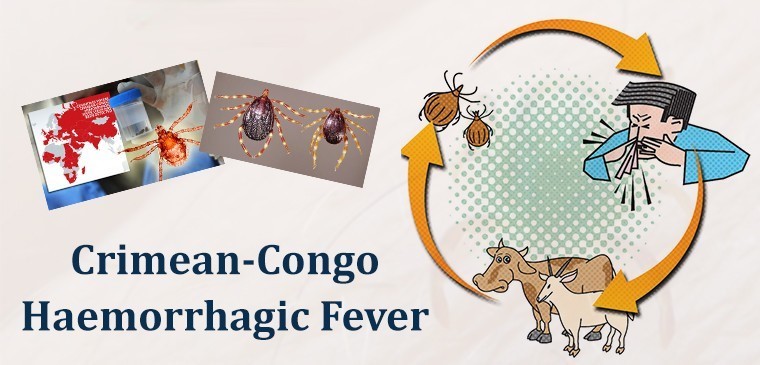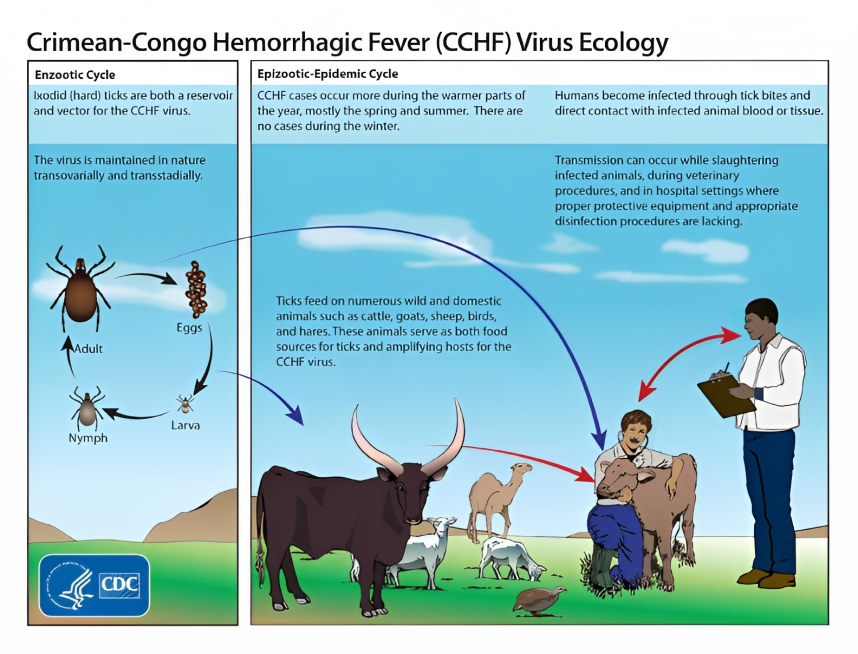Description

Copyright infringement not intended
Context: As Europe faces a severe heatwave and wildfires, the rising temperatures have also increased the risk of transmission of viruses that are usually confined to warmer regions. One of these viruses is the Crimean-Congo haemorrhagic fever (CCHF), a tick-borne infection that has a high fatality rate, according to the World Health Organization (WHO).
Details
- A deadly tick-borne disease that usually affects warmer regions is spreading across Europe as the continent faces a heatwave and wildfires, experts warn. The disease, known as Crimean-Congo haemorrhagic fever (CCHF), is caused by a virus that can be transmitted by ticks or through contact with infected blood or body fluids.
- The first death from CCHF in Europe occurred in Spain in 2016. Since then, more cases have been reported in Spain, Russia, Turkey, and the UK.
- Horizon, a magazine that covers European Union-funded research, reports that "Scientists are now warning that CCHF, which can kill between 10% and 40% of patients, is spreading northward and westward in Europe."
- In India, one person died of CCHF last month in Gujarat, the state that accounts for most of the country's cases of this disease.
- The World Health Organization (WHO) says that CCHF has a fatality rate of 10% to 40% and there is no specific treatment or vaccine available.

Crimean-Congo haemorrhagic fever (CCHF)
About
- Crimean-Congo haemorrhagic fever (CCHF) is a serious infectious disease that affects humans and animals.
- It is transmitted by ticks that carry the CCHF virus, which belongs to the Bunyaviridae family of viruses. The CCHF virus can cause outbreaks of severe bleeding and organ failure, with a high risk of death.
- CCHF is found in many regions of the world, including Africa, the Balkans, the Middle East and Asia. The main areas where the disease occurs are those where the ticks of the genus Hyalomma live.
- These ticks feed on a variety of wild and domestic animals, such as cattle, sheep, goats and ostriches. The animals do not show any signs of illness, but they can carry the virus in their blood for a short time after being bitten by an infected tick. This allows the virus to spread from one tick to another or from an animal to a human.
How do Humans get infected with CCHF?
- The main source of CCHF infection is the bite of an infected tick. Ticks are small blood-sucking parasites that live on animals such as cattle, sheep, goats and hares. They can also attach themselves to humans who come into contact with infected animals or vegetation.
- People can also get infected with CCHF by handling or slaughtering infected animals, or by consuming their raw milk or meat. In addition, people can catch the disease from other people who are already sick with CCHF, by touching their blood, secretions, organs or other bodily fluids.

What are the symptoms of CCHF?
- The symptoms of CCHF usually appear within 1 to 13 days after exposure to the virus. They include:
- Fever
- Headache
- Muscle and joint pain
- Nausea and vomiting
- Diarrhoea
- Stomach pain
- Sore throat
- Red eyes
- Jaundice (yellowing of the skin and eyes)
- Bleeding from the nose, gums, skin or internal organs
- Some people may develop severe complications such as shock, kidney failure, liver failure or coma.
- The death rate of CCHF can range from 10% to 40%, depending on the severity of the infection and the quality of medical care.
How is CCHF diagnosed and treated?
- CCHF can be diagnosed by testing blood samples for the presence of the virus or its antibodies. However, this requires specialized laboratory equipment and trained staff, which may not be available in some areas where CCHF occurs.
- There is no specific treatment or cure for CCHF. The main goal of treatment is to provide supportive care to relieve the symptoms and prevent complications. This may include:
- Fluid and electrolyte replacement
- Blood transfusion
- Oxygen therapy
- Antibiotics for secondary infections
- Painkillers and anti-inflammatory drugs
- Patients with CCHF should be isolated and treated in a hospital with strict infection control measures. Health workers and caregivers should wear protective clothing and gloves, and dispose of contaminated materials safely.
How can CCHF be prevented?
- There is no vaccine available for either people or animals to prevent CCHF. The best way to prevent CCHF is to avoid exposure to the virus. This can be done by:
- Wearing long sleeves, pants, hats and shoes when outdoors in areas where ticks are present.
- Applying insect repellents on skin and clothing.
- Inspecting yourself and your clothing for ticks after being outdoors, and removing them carefully.
- Avoiding contact with sick or dead animals, especially those that have signs of bleeding.
- Cooking animal products thoroughly before eating them.
- Practising good hygiene and washing your hands frequently.
- Using barrier methods such as condoms during sexual intercourse with someone who has or may have CCHF.
- Seeking medical attention as soon as possible if you develop symptoms of CCHF after being in a risk area.

Climate Change and the Spread of Diseases
About
- Climate change is not only affecting the environment but also the health of humans and animals. One of the consequences of climate change is the increased risk of infectious diseases, especially those transmitted by vectors such as ticks, mosquitoes, and fleas. These vectors can carry pathogens that cause diseases such as Lyme disease, malaria, dengue fever, Zika virus, and Crimean-Congo hemorrhagic fever (CCHF).
- According to the World Health Organization (WHO), climate change is expected to alter the distribution and abundance of these vectors, as well as their host animals and plants. This can lead to changes in the transmission patterns and geographic range of the diseases they carry. For example, as temperature patterns are disrupted, pathogens are thriving in geographies that traditionally had a climate hostile to them.
- The Centers for Disease Control and Prevention (CDC) says climate change contributes to the spread of diseases in multiple ways, including warmer temperatures expanding the habitat of ticks and other insects and giving them more time to reproduce; the habitat offered by water changing; and animals moving to newer areas and people coming into contact with them.
These changes pose a serious threat to public health and require coordinated action from governments, health authorities, researchers, and communities.
Some of the possible actions include:
- Monitoring and surveillance of vector-borne diseases and their vectors.
- Developing and implementing effective prevention and control strategies.
- Strengthening health systems and emergency preparedness.
- Raising awareness and educating the public about the risks and prevention measures.
- Promoting research and innovation to develop new tools and interventions.
- Reducing greenhouse gas emissions and mitigating the effects of climate change.
Conclusion
- Climate change and the spread of diseases are two interrelated global challenges that pose serious threats to human health and well-being. It affects the distribution and transmission of infectious diseases, such as malaria, dengue, and cholera, by altering the habitats and behaviours of their vectors and hosts. It also increases the risk of emerging and re-emerging diseases, such as COVID-19, by disrupting the ecological balance and creating favourable conditions for zoonotic spillovers. Therefore, it is imperative to adopt a holistic and multidisciplinary approach to address these complex and interconnected issues and to promote adaptation and mitigation strategies that can enhance the resilience and sustainability of human and natural systems.
Must-Read Articles:
Zoonosis: https://www.iasgyan.in/daily-current-affairs/zoonosis-theory#:~:text=A%20zoonosis%20is%20an%20infectious,a%20human%20and%20vice%20versa.
Livestock and Zoonosis: https://www.iasgyan.in/daily-current-affairs/livestock-and-zoonosis
|
PRACTICE QUESTION
Q. Climate change is not only affecting the environment but also the health of millions of people around the world. As the planet warms, new patterns of disease transmission emerge, exposing vulnerable populations to new threats. How can we address this growing concern? What are the main challenges and opportunities for preventing and controlling the spread of diseases linked to climate change? What are the best ways to adapt to changing conditions and protect our health and well-being?
|
https://indianexpress.com/article/explained/explained-health/climate-change-aiding-spread-of-deadly-virus-in-europe-what-is-cchf-8844383/












